Logic Supply ML100G-50 Fanless Skylake vPro Industrial NUC Review
by Ganesh T S on February 27, 2017 8:00 AM ESTPower Consumption and Thermal Performance
The power consumption at the wall was measured with a 1080p display being driven through the HDMI port. In the graphs below, we compare the idle and load power of the Logic Supply ML100G-50 with other low power PCs evaluated before. For load power consumption, we ran the AIDA64 System Stability Test with various stress components, as well as our custom Prime95 / Furmark stress routine, and noted the maximum sustained power consumption at the wall.


The power consumption numbers are typical of a fanless system sporting a 15W TDP processor. The addition of extra board components such as the USB 3.1 Gen 2 bridge chip (and the overall migration from a standard Intel NUC board to the ASRock Beebox one) makes the ML100G-50 idle at higher power levels compared to the ML100G-30. On the full loading side, it is interesting to note that the ML100G-50 is able to sustain a higher power draw compared to the ML100G-30.
Our thermal stress routine starts with the system at idle, followed by four stages of different system loading profiles using the AIDA64 System Stability Test (each of 30 minutes duration). In the first stage, we stress the CPU, caches and RAM. In the second stage, we add the GPU to the above list. In the third stage, we stress the GPU standalone. In the final stage, we stress all the system components (including the disks). Beyond this, we leave the unit idle in order to determine how quickly the various temperatures in the system can come back to normal idling range. The various clocks, temperatures and power consumption numbers for the system during the above routine are presented in the graphs below.
The AIDA64 system stability test uses real-world workloads to stress the system components. However, power virus tests such as the Prime 95 torture test and Furmark stability test can subject the system to greater stress. We repeated our thermal stress routine with 30 minutes of Prime 95 (v28.10), followed by 30 minutes of Prime 95 and Furmark (1.18.2). The Prime 95 load was then removed, and the GPU stressing Furmark test was allowed too run for another 30 minutes. The various clocks, temperatures and power consumption numbers for the system during the above routine are presented in the graphs below.
The two thermal stress routines reveal that the Core i5-6300U starts off with a 20W allowance for the package power consumption. Based on the workload, the thermal design appears to be able to handle it for around 15 - 20 minutes before the power throttling kicks in. The throttling kicks in when the package temperature reaches around 80C. The AVX instructions in Prime 95 tend to stress one part of the die, causing a more rapid rise in temperature, while the AIDA system stability test is more generic. Despite consuming 20W in both cases, the temperature reaches 80C faster with Prime 95. This causes the system to shift down to the 15W level earlier with the custom stress workload.
Another important aspect to keep note of while evaluating fanless PCs is the chassis temperature. Using the Android version of the FLIR One thermal imager, we observed the chassis temperature after the CPU package temperature reached the steady state value in the above graph. Similar to the ML100G-30, the ML100G-50 also ends up with a chassis temperature of around 67C after being subject to our thermal stress routines.
We have additional thermal images in the gallery below.
The thermal design of the ML100G-50 is very similar to that of the ML100G-30. Therefore, it is no surprise that the thermal profile for both systems under stress are almost the same. All in all, Logic Suply's chassis design ensures that the ML100G-50 is able to operate the CPU package at higher than the rated power numbers for an extended duration before falling back to the expected 15W levels.


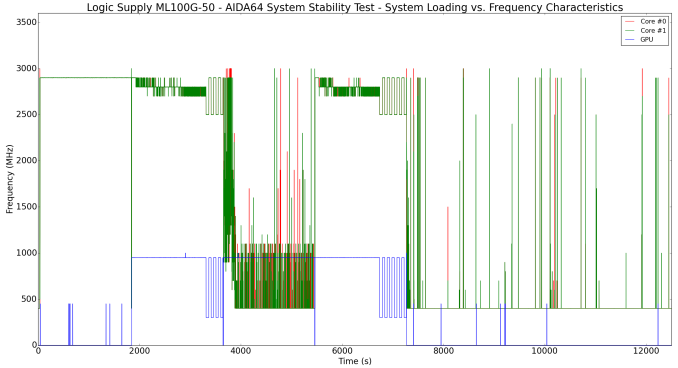
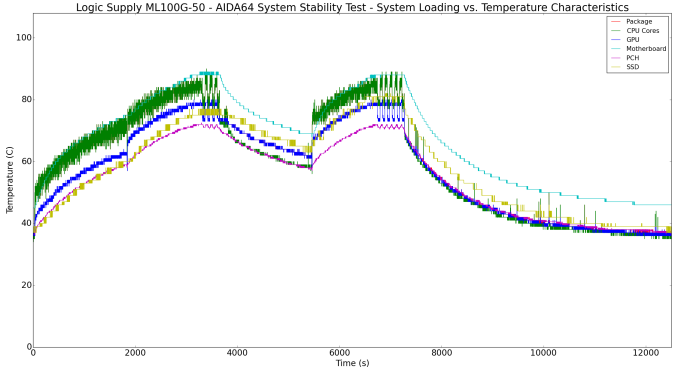
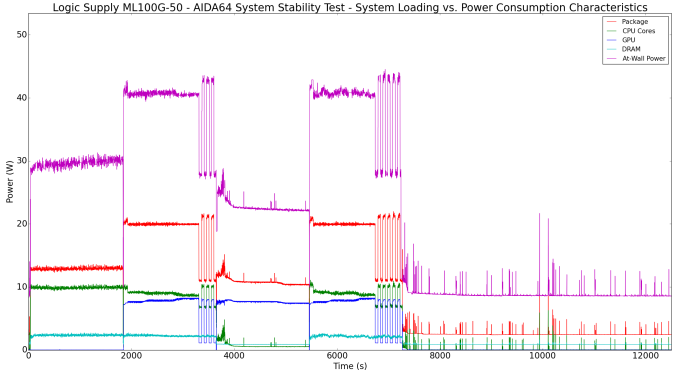
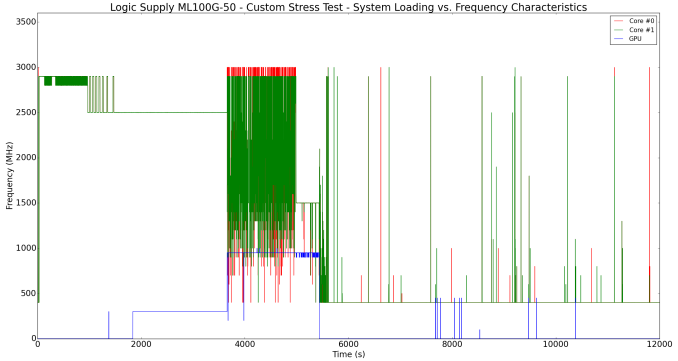
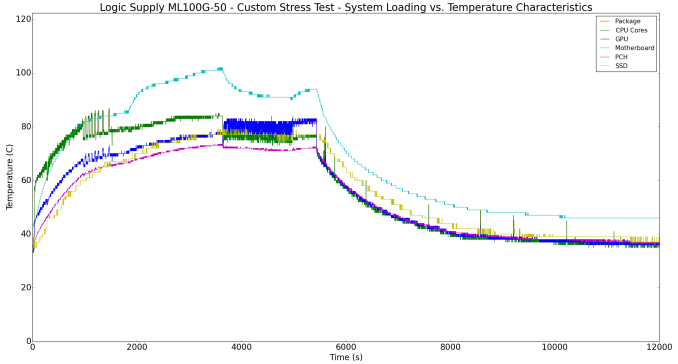

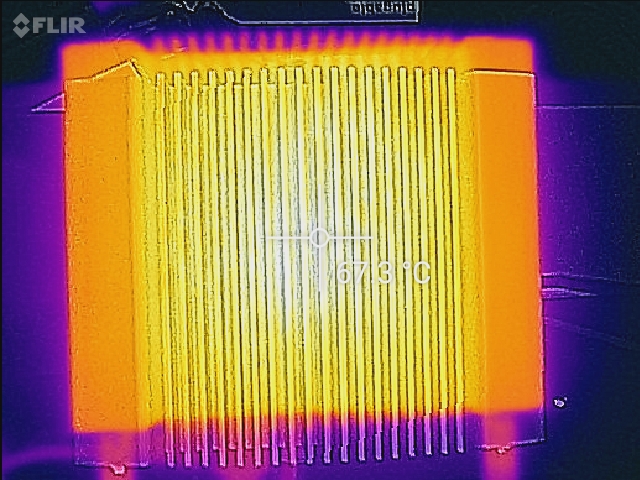














37 Comments
View All Comments
zepi - Monday, February 27, 2017 - link
Out of curiosity, what kind of ambient temperatures do you have in your test-bench?There is quite a difference between 18C and 28C room temperature in this kind of test.
bill.rookard - Monday, February 27, 2017 - link
Ideally you would think they would set ambient temp (via heat or a/c as needed) to a flat 21C/70F or so which is what most people would have as an average 'comfortable' temp. 28C might be a bit high (82F) while the 18C (64F) is a bit chilly.Although, considering these are 'industrial' type systems, you might actually subject them to a much wider dual temp test (15C/60F and 32C/90F) which you might find in a warehouse or factory floor.
zepi - Monday, February 27, 2017 - link
This is what I'm referring to. If someone deploys this at factory floor, temperature variations might be completely out of your standard AC'ed office block.Knowing ambiet temp would definitely help people estimating the dT figures that it can handle.
ganeshts - Monday, February 27, 2017 - link
The ambient temperature for all our thermal testing is between 70 and 74F.For one of our previous industrial PC reviews, I did the stress testing at multiple temperature points - http://www.anandtech.com/show/6494/aleutia-relia-i... , but the overall feedback in terms of balance between time spent on a review and actionable results was that room temperature testing is more than enough.
If the customer is ordering, say, 20K or 30K worth of these PCs, I am sure Logic Supply would be more than happy to deliver those graphs for the particular workloads to be used at different temperature points [ just my opinion :) ]
Samus - Tuesday, February 28, 2017 - link
The issue I think he is raising is the typical ambient temperature of a ventilated kiosk or summertime warehouse is probably 90F. Who knows how high it is when not ventilated. For a review of an industrial PC, it would probably be appropriate to increase your ambient temp to real-world scenarios.SkipPerk - Wednesday, April 19, 2017 - link
Our facilities routinely top 105 in August. I had to use a laptop cooler to keep my Asus ultrabook from slowing down excessively. I updated both required PC's to large CPU coolers (Noctua NH-12) and filled every fan slot (plus we ALWAYS use dust filters or else the motherboards get so dusty that when it gets humid they short out on wet dust).Temperature is a valid question. I have seen boxes in digital signage that get insanely hot (think 130 degrees F). You not only need fans, but you want to ventilate the box the computer is in. An old server Delta fan for an intake and an outtake will drop an enclosure down to five or ten degrees above ambient.
Outside temps matter considerably in the summer. As does humidity.
Meteor2 - Monday, February 27, 2017 - link
I think most people go for 19 C these days if using heating. Uses 20% less energy than 21 C.eldakka - Monday, February 27, 2017 - link
At least for this product being tested, the specifications from their website are:Operating Temperature Range 0°C ~ 50°C
Therefore, in theory at least, any ambient temperature likely to be found inside a livable room should be satisfactory for this device.
Can't speak for the other devices like the ECS or Zotac machines tho.
Ro_Ja - Monday, February 27, 2017 - link
It looks like a big heat sink itself.tipoo - Monday, February 27, 2017 - link
It is. It's fanless, uses the whole case as a heatsink.